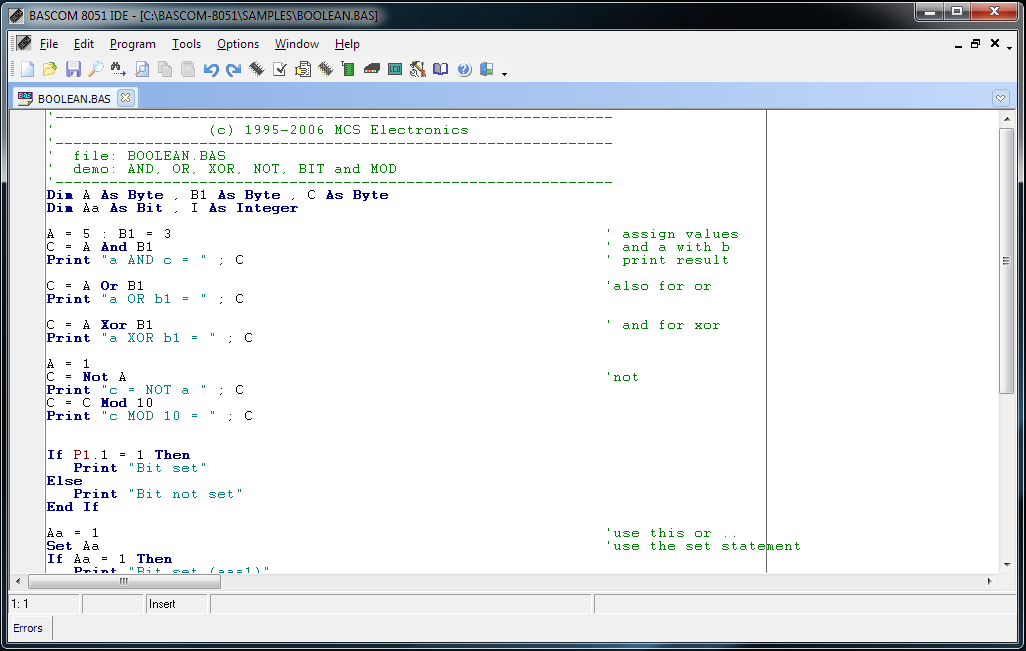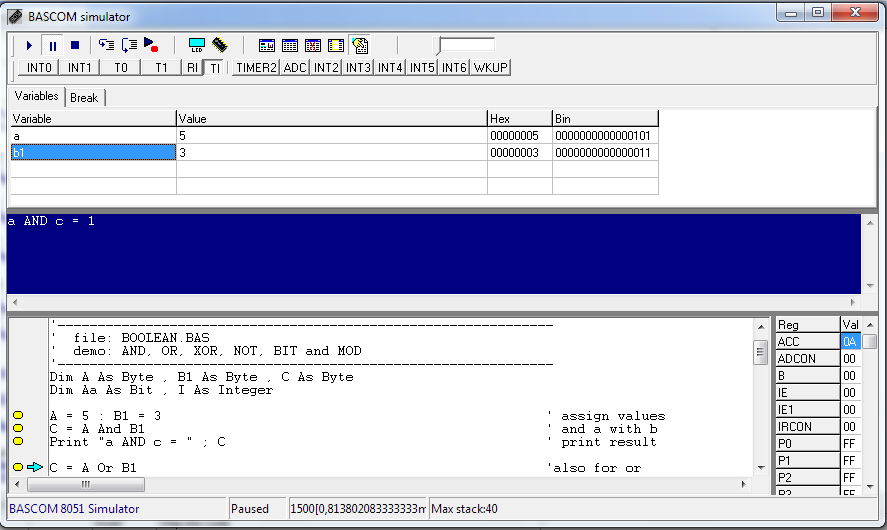BASCOM-AVR© is the original Windows BASIC COMPILER for the AVR family. It is designed to run on XP/VISTA/WIN7 and WIN8
This product description is updated in 2014. But we do not change it each time we update the software. In the on line help you can find a list of all statements and functions.
Key Benefits
- Structured BASIC with labels.
- Structured programming with IF-THEN-ELSE-END IF, DO-LOOP, WHILE-WEND, SELECT- CASE.
- Fast machine code instead of interpreted code.
- Variables and labels can be as long as 32 characters.
- Bit, Byte, Integer, Word, Long, Single, Double and String variables.
- Large set of Trig Floating point functions.
- Date & Time calculation functions.
- Compiled programs work with all AVR microprocessors that have internal memory.
- Statements are highly compatible with Microsoft’s VB/QB.
- Special commands for LCD-displays , I2C chips and 1WIRE chips, PC keyboad, matrix keyboad, RC5 reception, software UART, SPI , graphical LCD, send IR RC5,RC6 or Sony code.
- TCP/IP with W3100A/W5100/W5200/W5300 chips.
- Built in AVR-DOS functions like MKDIR, CHDIR, DIR, OPEN, CLOSE, etc. Just as they work in QB/VB !
- Local variables, user functions, library support.
- Integrated terminal emulator with download option..
- Integrated simulator for testing.
- Integrated ISP programmer (application note AVR910.ASM).
- Integrated STK200 programmer and STK300 programmer. Also supported is the low cost Sample Electronics programmer. Can be built in 10 minutes! Many other programmers supported via the Universal Interface.
- Many supported programmer like STK500, STK600, MKII, USBASP, JTAG , Arduino
- Editor with statement highlighting.
- Context sensitive help.
- DEMO version compiles 4KB of binary code. Well suited for the ATmega48.
- English an German Books available
- AT mouse simulator, AT keyboard simulator, I2C Slave available as add on.
- This product is developed in 1995 and is updated regularly.
The following statements are supported (actually there are many more look in the on line helpfile):
Decision and structuresIF, THEN, ELSE, ELSEIF, END IF, DO, LOOP, WHILE, WEND, UNTIL, EXIT DO, EXIT WHILE, FOR, NEXT, TO, STEP, EXIT FOR, ON .. GOTO/GOSUB, SELECT, CASE.
Input and outputPRINT, INPUT, INKEY, PRINT, INPUTHEX, LCD, UPPERLINE, LOWERLINE,DISPLAY ON/OFF, CURSOR ON/OFF/BLINK/NOBLINK, HOME, LOCATE, SHIFTLCD LEFT/RIGHT, SHIFTCURSOR LEFT/RIGHT, CLS, DEFLCDCHAR, WAITKEY, INPUTBIN, PRINTBIN, OPEN, CLOSE, DEBOUNCE, SHIFTIN, SHIFTOUT, GETATKBD, SPC, SERIN, SEROUT
Numeric functionsAND, OR, XOR, INC, DEC, MOD, NOT, ABS, BCD, LOG, EXP, SQR, SIN,COS,TAN,ATN, ATN2, ASIN, ACOS, FIX, ROUND, MOD, SGN, POWER, RAD2DEG, DEG2RAD, LOG10, TANH, SINH, COSH.
I2CI2CSTART, I2CSTOP, I2CWBYTE, I2CRBYTE, I2CSEND and I2CRECEIVE.
1WIRE1WWRITE, 1WREAD, 1WRESET, 1WIRECOUNT, 1WSEARCHFIRST, 1WSEARCHNEXT.
SPISPIINIT, SPIIN, SPIOUT, SPIMOVE.
CAN
CONFIG CANBUSMODE, CONFIG CANMOB, CANBAUD, CANRESET, CANCLEARMOB, CANCLEARALLMOBS, CANSEND, CANRECEIVE , CANID, CANSELPAGE, CANGETINTS
TCP/IP
TCP/IP routines can be used with the W3100/IIM7000/IIM7010/W5100/W5200/W5300 modules.
BASE64DEC , BASE64ENC , IP2STR , UDPREAD , UDPWRITE , UDPWRITESTR , TCPWRITE , TCPWRITESTR , TCPREAD ,GETDSTIP , GETDSTPORT , SOCKETSTAT , SOCKETCONNECT ,SOCKETLISTEN , GETSOCKET , SOCKETCLOSE , SETTCP , GETTCPREGS , SETTCPREGS , SETIPPROTOCOL , TCPCHECKSUM , SOCKETDISCONNECT , SNTP , TCPREADHEADER ,UDPREADHEADER
Interrupt programmingON INT0/INT1/TIMER0/TIMER1/SERIAL, RETURN, ENABLE, DISABLE, COUNTERx, CAPTUREx, INTERRUPTS, CONFIG, START, LOAD.
Bit manipulationSET, RESET, ROTATE, SHIFT, BITWAIT, TOGGLE.
VariablesDIM, BIT , BYTE , INTEGER , WORD, LONG, SINGLE, DOUBLE, STRING , DEFBIT, DEFBYTE, DEFINT, DEFWORD.
MiscellaneousREM, ' , SWAP, END, STOP, CONST, DELAY, WAIT, WAITMS, GOTO, GOSUB, POWERDOWN, IDLE, DECLARE, CALL, SUB, END SUB, MAKEDEC, MAKEBCD, INP,OUT, ALIAS, DIM , ERASE, DATA, READ, RESTORE, INCR, DECR, PEEK, POKE, CPEEK, FUNCTION, READMAGCARD, BIN2GREY, GREY2BIN, CRC8, CRC16, CRC32, CHECKSUM.
Compiler directives$INCLUDE, $BAUD and $CRYSTAL, $SERIALINPUT, $SERIALOUTPUT, $RAMSIZE, $RAMSTART, $DEFAULT XRAM, $ASM-$END ASM, $LCD, $EXTERNAL, $LIB.
String manipulationSTRING, SPACE, LEFT, RIGHT, MID, VAL, HEXVAL, LEN, STR, HEX, LTRIM, RTRIM, TRIM, LCASE, UCASE, FORMAT, FUSING, INSTR, CHARPOS.
And many other functions, statements and directives
To make a program takes just a few steps :
- Write the program in BASIC
- Compile it to fast machine binary code
- Test the result with the integrated simulator(with additional hardware you can simulate the hardware too).
- Program the chip with one of the integrated programmers.(hardware must be purchased separately)
This is a screen shot of the editor. You can work in normal mode or project mode.
At the left you find the Code Explorer. The Code explorer can show unused data in a different colour.
When the Code Explorer is visible, the editor supports Proper Indent and Indent drawing.
Indent lines can be a great visual help.
A tool tip with info can be shown by pressing SHIFT :
Here it is clear that BDIL is a byte variable, dimensioned in the module CAN-Elektor.bas
It will show info for constants, aliases, variables and functions.










